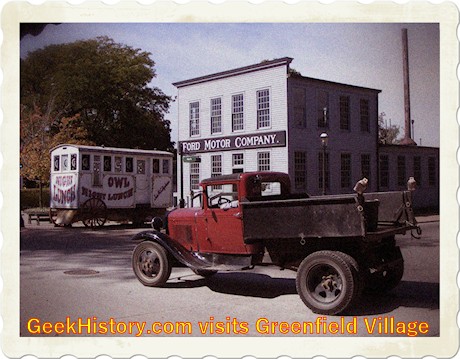 Henry Ford created the ultimate geek history museum complex of the Industrial Revolution in Dearborn, Michigan, a suburb of Detroit.
Henry Ford created the ultimate geek history museum complex of the Industrial Revolution in Dearborn, Michigan, a suburb of Detroit.
Collectively called "The Henry Ford" the history museum complex is comprised of the large indoor Henry Ford Museum, and the outdoor Greenfield Village. The museum complex also has an IMAX movie theatre and offers the Ford Rouge Factory Tour.
Ford collects the history of the common man
In the Chicago Tribune in 1916 Henry Ford was quoted as saying that "history is more or less bunk." Ford qualified that remark by saying he was referring to written history which talked about wars and politicians, but the history taught in school did not record the history of the common man.
By the late 1920s, Henry Ford had become the primary collector of Americana in the world. Ford started with collecting antiques and household goods, but he later moved on to collecting historic structures with the creation of Greenfield Village in Dearborn, Michigan. Ford also began collecting materials for a museum with a theme of practical technology.
The Edison Institute opened in 1929 as a private site for educational purposes only, based on Henry Ford's desire to preserve items of historical significance and portray the Industrial Revolution. The Edison Institute Museum, now known as The Henry Ford Museum, is a traditional museum reflecting Henry Ford's love of farm tools, home appliances, furniture and industrial machines. There are also large exhibits of automotive and locomotive technology.
Greenfield Village
Next door to the Henry Ford Museum is Greenfield Village, a vast array of famous homes and buildings that Henry Ford moved from their original location and reconstructed there. One of the most interesting analogies I have heard describing Greenfield Village is that Henry Ford collected buildings like some people collect stamps.
The original purpose for Greenfield Village, from Henry Ford's point of view, was for educational purposes. He felt the best way for the country's youth to learn by experiencing things first-hand. Many of the first buildings at Greenfield Village were from the life of Henry Ford and Thomas Edison. Ford named it Greenfield Village, after his wife's hometown.
Greenfield Village started with a loving restoration of Ford's boyhood home. When workmen recovered broken bits of his mother's dishes, Ford had her china reproduced and placed on the shelves just as it had been when he was growing up. He built a replica of the workbench where he had repaired watches as a boy, scoured antique shops to find furniture he remembered from his youth, and filled dresser drawers with shawls like those his mother had worn.